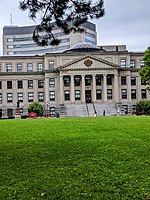Rideau Skating Rink

The Rideau Skating Rink was an indoor skating and curling facility located in Ottawa, Ontario, Canada. Consisting of a curling rink and a skating rink, it was one of the first indoor rinks in Canada. The Rideau Rink was scheduled to open on January 10, 1889, but unseasonably mild weather postponed the grand opening to February 1. It opened on January 25, 1889 for select V.I.P.s although this was a misunderstanding and should not have denied entry to season ticket holders. It was located on Theodore Street, (now Laurier Avenue) at Waller Street, at the present location of the Arts Hall of the University of Ottawa, near the Rideau Canal. Besides curling and recreational skating, the rink was also used for ice hockey and figure skating. It was the site of the first recorded organized women's ice hockey game on March 8, 1889. It was also the site of the first Ontario men's ice hockey championship game on March 7, 1891.
Excerpt from the Wikipedia article Rideau Skating Rink (License: CC BY-SA 3.0, Authors, Images).Rideau Skating Rink
Laurier Avenue East, (Old) Ottawa Sandy Hill
Geographical coordinates (GPS) Address Phone number Website Nearby Places Show on map
Geographical coordinates (GPS)
| Latitude | Longitude |
|---|---|
| N 45.4237 ° | E -75.6858 ° |
Address
University of Ottawa
Laurier Avenue East 75
K1N 6N5 (Old) Ottawa, Sandy Hill
Ontario, Canada
Open on Google Maps






